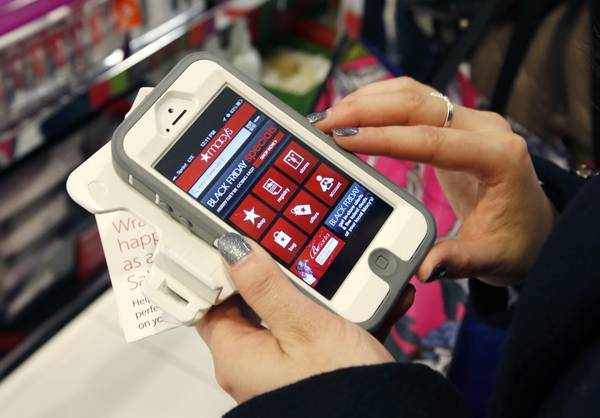In the midst of the “E-pocalypse,” with e-commerce growing at such a rapid pace that online shopping is threatening to overtake bricks-and-mortar retail, experts in real estate, retail and economics offered optimistic outlooks for the market in Las Vegas.
The local office of commercial real estate giant CBRE brought together experts from the firm’s national and local contingents on Nov. 3 to speak to the media and review trends for the holidays and the coming year.
Online shopping has been growing at a rate of 15 percent per year, compared with 4 percent bricks-and-mortar sales growth, so one might think that traditional storefronts are struggling.
Melina Cordero, chief of CBRE retail research for the Americas, though, said that’s not the case. Although online shopping is exploding in popularity, bricks-and-mortar retailers are expanding into the online space and integrating the in-store experience with the advantages of online shopping, research shows.
“The consumer likes shopping online, but loves omnichannel shopping more,” Cordero said. “They will browse online, try it on in-store and buy on their phones.”
Over 50 percent of online sales are through bricks-and-mortar brands on their websites, she added.
Although several department stores that once dominated the retail space are experiencing tough times — from shuttering locations to filing for bankruptcy — discount retailers will be the big winners this holiday season, Cordero said.
The health and beauty industry and home furnishings will do well this Christmas regardless, she said. But the real winners will be discounters such as T.J. Maxx and Burlington Coat Factory. Deals are still important to post-recession consumers, she said. They are willing to pay more for some branded items, but not on everyday items such as plain T-shirts.
Among other topics addressed by CBRE’s experts were:
High expectations for Las Vegas
Las Vegas has been a retail juggernaut, on the Strip and in the suburban cores, and CBRE sees the trend continuing as other industries in the area simultaneously rise.
“Our economy continues to grow and is doing so much better,” said Matt Bear, vice president of global gaming retail for CBRE. “It’s about to take off when the construction being done in the city starts to take hold.”
Projects planned and underway will attract more workers who will in turn support more retail, he said.
The general economy is slowing on the national level, said Matt Vance, economist and director of research and analysis for CBRE, but research indicates that Las Vegas will continue to do well in its bounce-back. One reason is that the area is benefiting from national migration patterns.
“It’s a chicken-and-egg discussion,” Vance said. “Do the jobs come and people follow, or is it the people then jobs? But really, the net migration patterns within the lower 48 states are playing big roles in the success of inland markets such as Las Vegas, Phoenix and Denver.”
Las Vegas has added more jobs fairly consistently, and “a lot of that is being driven by the net migration flow into market from 2012 to 2016,” Vance said.
Focus on buying habits of millennials
In Las Vegas and nationally, retailers will continue to focus on millennials even though baby boomers and Gen Xers might have more disposable income overall.
Cordero observed that while boomers may have a lot of income, they spend differently — millennials spend money on experiential activities such as eating out. But she predicts that will change.
“As they age, older consumers will shift money away from goods while millennials will be shifting their spending toward goods,” Cordero said. “Millennials are not too different and will be moving to suburbs and buying cars.
“By focusing on millennials, retailers are preparing for the massive amount of spending that will be coming from that (group).”
Studies show that millennials are holding back from spending on more traditional categories such as apparel, but will put their money toward convenience-driven categories like ride -hailing services and gyms, she said.
“The millennials as a cohort don’t want to spend more than $10 on a white T-shirt, but they are willing to spend $35 at Soul Cycle,” Cordero said. “So you can’t call millennials cheap, because they’re spending money on Uber, restaurants and gyms.”
Shopping as a social experience
Social media is playing a big role in how retailers and landlords are trying to attract millennials to their stores. With the popularity of online shopping exploding over the past decade, there is less need to go to physical shopping areas.
Retailers and landlords recognize this trend and are trying to work with it, rather than fight it.
“One of the things we’re going to see a lot this holiday season are these staged areas of the mall or retail (complexes), where they are encouraging Instagram, Snapchat and Twitter photos, to try and drive viral social media campaigns,” Cordero said. “People take photos, they put (them) out there, and people see it and then want to go and see it themselves.”
Some mall groups in California are partnering with ride-hailing giant Uber to incentivize spending a certain amount to earn free drop-off and pick-up. Cordero said to expect more of these types of partnerships going forward in the retail realm.
“It’s going to end up looking like affiliate marketing,” Bear said. “I don’t know what it’s ultimately going to look like, but there are going to be more innovative partnerships.”
Those properties and landlords willing to take the extra steps — or even take risks — to attract millennial dollars likely will be on the winning side of the retail shift.
“The internet economy is creating the haves and have-nots,” Bear said. “If you’re innovative and have the best environment and have the savvy and investment dollars to create partnerships, you’re going to end up winning a bigger piece of the economic pie. That is the inescapable conclusion.”

